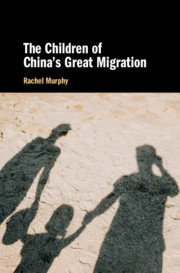Book contents
- The Children of China’s Great Migration
- The Children of China’s Great Migration
- Copyright page
- Contents
- Figures and Maps
- Tables
- Acknowledgements
- 1 Understanding the Lives of Left-Behind Children in Rural China
- 2 Migration, Education and Family Striving in Four Counties of Anhui and Jiangxi
- 3 Sacrifice and Study
- 4 Boys’ and Girls’ Experiences of Distribution in Striving Families
- 5 Children in ‘Mother At-Home, Father Out’ Families
- 6 Children of Lone-Migrant Mothers and At-Home Fathers
- 7 Children in Skipped Generation Families
- 8 Left-Behind Children in Striving Teams
- Appendix: Field Research on Left-Behind Children in China
- Bibliography
- Index
6 - Children of Lone-Migrant Mothers and At-Home Fathers
Published online by Cambridge University Press: 06 August 2020
- The Children of China’s Great Migration
- The Children of China’s Great Migration
- Copyright page
- Contents
- Figures and Maps
- Tables
- Acknowledgements
- 1 Understanding the Lives of Left-Behind Children in Rural China
- 2 Migration, Education and Family Striving in Four Counties of Anhui and Jiangxi
- 3 Sacrifice and Study
- 4 Boys’ and Girls’ Experiences of Distribution in Striving Families
- 5 Children in ‘Mother At-Home, Father Out’ Families
- 6 Children of Lone-Migrant Mothers and At-Home Fathers
- 7 Children in Skipped Generation Families
- 8 Left-Behind Children in Striving Teams
- Appendix: Field Research on Left-Behind Children in China
- Bibliography
- Index
Summary
Chapter 6 discusses children’s relationships with their parents when a mother had migrated while a father stayed at home. This configuration was rare because it so contravened local gender norms it usually signalled inherent family vulnerabilities, typically economic hardship and a father’s physical impairment or else marital discord. In these ‘weak’ families, academically gifted children held out some hope to their parents that with support from the mother’s remittances, the family could strengthen over time. But in families where parents’ relationships were discordant, migrant mothers could be side-lined, while the parents’ divorce or a father’s death could trigger a migrant mother’s complete exit from the striving team. Men whose wives had migrated alone were at gravest risk of negative gender assessment if they earned little. They therefore tried to shore up their masculine worth by entrusting the ‘women’s work’ of childcare to the children’s grandmothers while stressing their commitments outside the home. But intimacy could still develop between the left-behind fathers and children. The family circumstances and the academic aptitude of the children of lone-migrant mothers differed but these children all had to contend with striving pressures and with managing relationships in families perceived by others to be social oddities.
Keywords
- Type
- Chapter
- Information
- The Children of China's Great Migration , pp. 162 - 180Publisher: Cambridge University PressPrint publication year: 2020



